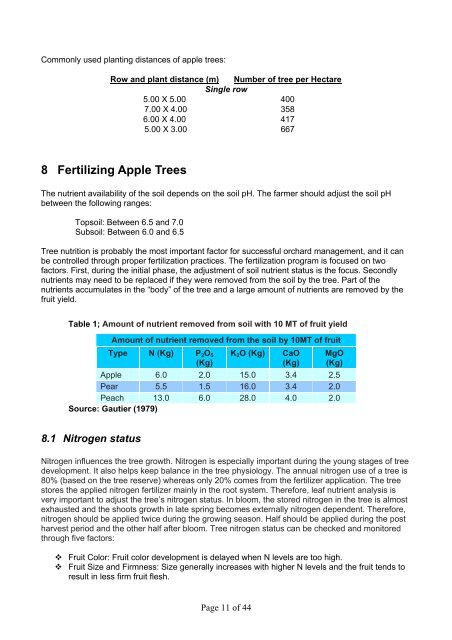Apple Production Manual, Roots of Peace, Nov. 2008
Apple Production Manual, Roots of Peace, Nov. 2008
Apple Production Manual, Roots of Peace, Nov. 2008
Create successful ePaper yourself
Turn your PDF publications into a flip-book with our unique Google optimized e-Paper software.
Commonly used planting distances <strong>of</strong> apple trees:<br />
Row and plant distance (m) Number <strong>of</strong> tree per Hectare<br />
Single row<br />
5.00 X 5.00 400<br />
7.00 X 4.00 358<br />
6.00 X 4.00 417<br />
5.00 X 3.00 667<br />
8 Fertilizing <strong>Apple</strong> Trees<br />
The nutrient availability <strong>of</strong> the soil depends on the soil pH. The farmer should adjust the soil pH<br />
between the following ranges:<br />
Topsoil: Between 6.5 and 7.0<br />
Subsoil: Between 6.0 and 6.5<br />
Tree nutrition is probably the most important factor for successful orchard management, and it can<br />
be controlled through proper fertilization practices. The fertilization program is focused on two<br />
factors. First, during the initial phase, the adjustment <strong>of</strong> soil nutrient status is the focus. Secondly<br />
nutrients may need to be replaced if they were removed from the soil by the tree. Part <strong>of</strong> the<br />
nutrients accumulates in the “body” <strong>of</strong> the tree and a large amount <strong>of</strong> nutrients are removed by the<br />
fruit yield.<br />
Table 1; Amount <strong>of</strong> nutrient removed from soil with 10 MT <strong>of</strong> fruit yield<br />
Amount <strong>of</strong> nutrient removed from the soil by 10MT <strong>of</strong> fruit<br />
Type N (Kg) P2O5<br />
(Kg)<br />
Page 11 <strong>of</strong> 44<br />
K2O (Kg) CaO<br />
(Kg)<br />
MgO<br />
(Kg)<br />
<strong>Apple</strong> 6.0 2.0 15.0 3.4 2.5<br />
Pear 5.5 1.5 16.0 3.4 2.0<br />
Peach 13.0 6.0 28.0 4.0 2.0<br />
Source: Gautier (1979)<br />
8.1 Nitrogen status<br />
Nitrogen influences the tree growth. Nitrogen is especially important during the young stages <strong>of</strong> tree<br />
development. It also helps keep balance in the tree physiology. The annual nitrogen use <strong>of</strong> a tree is<br />
80% (based on the tree reserve) whereas only 20% comes from the fertilizer application. The tree<br />
stores the applied nitrogen fertilizer mainly in the root system. Therefore, leaf nutrient analysis is<br />
very important to adjust the tree’s nitrogen status. In bloom, the stored nitrogen in the tree is almost<br />
exhausted and the shoots growth in late spring becomes externally nitrogen dependent. Therefore,<br />
nitrogen should be applied twice during the growing season. Half should be applied during the post<br />
harvest period and the other half after bloom. Tree nitrogen status can be checked and monitored<br />
through five factors:<br />
Fruit Color: Fruit color development is delayed when N levels are too high.<br />
Fruit Size and Firmness: Size generally increases with higher N levels and the fruit tends to<br />
result in less firm fruit flesh.



